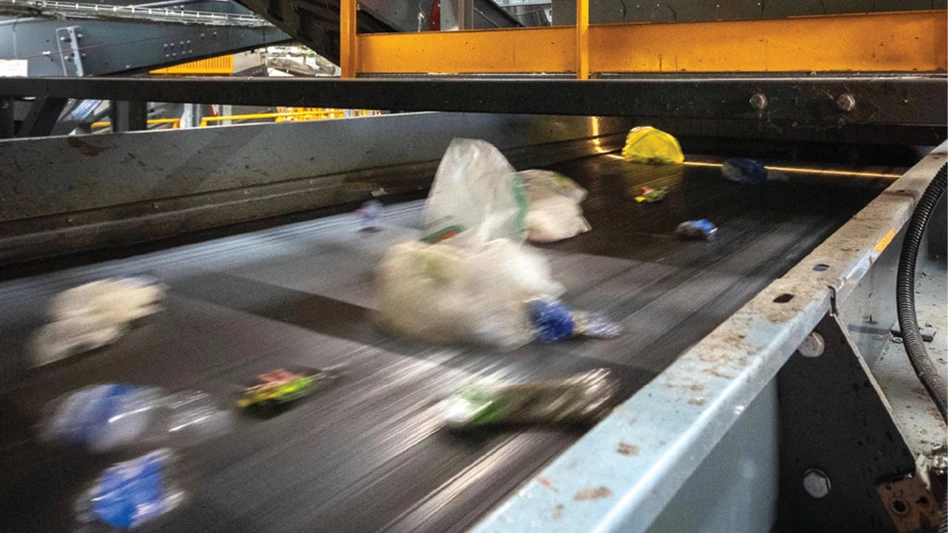

Today’s optical sorters are finely tuned machines. Their software and hardware components work together in a carefully orchestrated symphony to deliver high-purity recycled products from complex feedstock at high throughput rates.
If even one of these components is out of tune, the entire circuit’s productivity and final product purity suffers.
Selecting the right optical sorter with the right technology supplier is the first step in delivering the desired sorting performance.
However, every day, week and month, the machine’s operator must keep a careful eye on and maintain the components of the optical sorter to ensure it works at peak performance, optimizing profitability.
Consider following these tips to properly maintain sorting equipment.
Calibrating the illumination unit
Optical sorters found in the typical material recovery facility (MRF) or municipal solid waste (MSW) sorting plant process what the human eye can see, but at much higher rates. While optional technologies are available to meet specific application needs, two standard technologies often are employed by most optical sorters: visual spectroscopy (VIS) and near-infrared (NIR).
It is crucial the sorter’s illumination unit is calibrated so the software accurately detects color and material properties. Any environmental change—bulb wear and aging, temperature variations, etc.—can alter the way an optical sorter sees material.
Although calibrating optical sorters cuts into production schedules, doing so on a sometimes daily or weekly basis will help optimize sorting performance at a MRF or MSW plant.
When working with your technology supplier, ask how quickly and how often calibration should be performed. Some sorters offer continuous calibration, which constantly computes and maintains VIS and NIR signals to tolerance.

Perform valve checks
Most optical sorters apply the same mechanical process to sort material. Air valves produce jet pulses of air at precisely timed intervals to eject either the desired material or contamination in a touchless sorting process. The valve blocks on these sorters can have hundreds of individual valves, depending on the belt width.
To work properly, these valves must remain clean and clear of debris. However, the operating environment or oil and water in the air lines can clog or completely block a valve, which causes recycled product purity to suffer.
Operators must check valves for high and low pressure to ensure each valve is working properly. A broken or clogged valve leads to lost output or contaminated final product.
In the past, technicians had to go to each machine separately to perform valve checks manually, which frequently led to human error when assessing and documenting valve performance. Today, some optical sorters offer auto testing and cleaning of the valves to ensure optimal sorting performance and purity. The testing and cleaning process occurs automatically when the circuit stops, removing the chance for human error. Detected damaged valves are reported on the machine’s control panel or to the control room or machine app in the case of a connected machine.
Check belt speeds
Paramount to an optical sorter’s success is belt speed, because the correct belt speed proves to be the difference between high product purity or increased material contamination.
With every optical sorter, the software calculates the material’s distance by dividing belt speed to compute the proper air valve firing time and location. This is the key to optimizing the product sort.
Multiple factors can contribute to belt speed changes: belt wear, bearings, gears and debris buildup. A belt running faster or slower than the established belt speed leads to a valve firing too early or late, resulting in product losses or contamination.
Therefore, it is essential to check for the correct belt speed multiple times throughout each shift. If the sorter’s material feeder is not equipped with sensors, an employee must manually check speed with a tachometer and make any necessary adjustments.
Automation, again, can assist with this process. Some sorters come with sensors that continuously monitor belt speeds and alerts operators upon detecting a belt speed change. If a sensor fails, some of these systems also provide an automatic alert.
Keep optical sorters clean
While intuitive and apparent, keeping a clean sorter is an important component to an accurate sorting process. Optical sorters require consistent light intensity to properly detect the material, but they often work in dirty environments. Debris that builds up on an externally mounted illumination unit can pose a fire hazard.
Workers must wipe down the encasement glass so the sensor’s field of view is not obstructed. And while cleaning, inspect for any damage from flying debris. Verify that external lamps are in correct alignment, as flying debris easily could strike them. If realignment is necessary, workers should recalibrate the machine to optimize performance.
Any type of cleaning requires the circuit to be shut down, which cuts into production. Cleaning efforts are reduced when operating sensor-based sorters with illumination units mounted inside the scanner box. Also, sorters offering quick-access panels to the scanner and valve block will help to minimize downtime for cleaning.

Stock up on spare parts
Keep enough critical and high-attrition parts on hand for quick replacement to minimize maintenance-related downtime, and stock up on parts such as air filters for the air machine, lamps and valves.
Not having parts readily available comes with an additional cost. A bulb takes 10 minutes to replace if it is in stock. If not, it requires one to two days to replace, plus the cost of overnight shipping and circuit downtime.
Leverage technology
More manufacturers now offer remote support and connectivity programs for optical sorters. With a connected asset, manufacturers can resolve many machine sorting issues remotely through a virtual private network. With a call, text or email, customers can connect with the manufacturer to resolve performance issues more quickly than with a site visit.
Additionally, some manufacturers also offer advanced production information harvesting programs that are designed to provide actionable data on sorting performance. These types of programs can alert management and service technicians to machine issues as they occur, allowing small service items to be addressed before they become larger problems.
Also, work with the optical sorter technology supplier to develop a service contract to ensure long-term maximum circuit performance.
Regardless of the level of support needed, sorter manufacturers are available to partner with recyclers so they can optimize throughput with high purity levels and maximize profitability.
Get curated news on YOUR industry.
Enter your email to receive our newsletters.

Explore the October 2023 Issue
Check out more from this issue and find your next story to read.
Latest from Recycling Today
- Republic Services, Blue Polymers open Indianapolis recycling complex
- Altilium produces EV battery cells using recycled materials
- Brightmark enters subsidiaries of Indiana recycling facility into Chapter 11
- Freepoint Eco-Systems receives $50M loan for plastics recycling facility
- PET thermoform recycling the focus of new NAPCOR white paper
- Steel Dynamics cites favorable conditions in Q1
- Hydro starts up construction in Spain
- Rebar association points to trade turmoil





